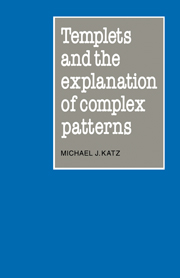Book contents
- Frontmatter
- Contents
- Prologue
- Introduction
- 1 Scientific abstractions
- 2 The nature of explanation
- 3 Configurational explanations
- 4 Templeting
- 5 Self-assembly
- 6 Rules for configurational explanations
- 7 Simple, complex and random
- 8 Reductionism
- Appendix: A pattern theoretic formalization
- Quotation index
- Subject index
- Frontmatter
- Contents
- Prologue
- Introduction
- 1 Scientific abstractions
- 2 The nature of explanation
- 3 Configurational explanations
- 4 Templeting
- 5 Self-assembly
- 6 Rules for configurational explanations
- 7 Simple, complex and random
- 8 Reductionism
- Appendix: A pattern theoretic formalization
- Quotation index
- Subject index
Summary
Reduction … is the explanation of a theory or a set of experimental laws established in one area of inquiry, by a theory usually though not invariably formulated for some other domain.
[E. Nagel (1961) The Structure Of Science. Problems In The Logic Of Scientific Explanation Harcourt, Brace & World NY, p. 33.8.]Science strives to reduce our experiences to symbols. Experiences are colorful, multi-faceted, and fuzzy along the edges; symbols are bland, one-dimensional, and precisely-bounded. Real world observations can be bulky and ill-shaped and can have both strong and tenuous ties with a myriad of other real world observations; abstractions are built of simple, smooth-surfaced elements, uncoupled from other constructs, and abstractions can easily be carried in one's pocket. Scientifically, we give up the shifting and elusive mystery of the world, but, in exchange, we gain the standardized and reproducible abstractions from which we can build precise determinate explanations.
The reduction of experience to useful symbols – the construction of scientific abstractions – is the essential scientific endeavor. In this sense, all of science is reductionism. At the same time, there is another sense to scientific reductionism. Once a real world phenomenon has been abstracted, the scientist attempts to create a scientific explanation of that abstraction, and this too is a type of reductionism. To reduce is to recreate, and reductionism is actually constructionism.
A scientific abstraction is a model of some real world phenomenon, and a scientific explanation is then a further transformation of that phenomenon, carried out largely in the abstract realm.
- Type
- Chapter
- Information
- Templets and the Explanation of Complex Patterns , pp. 85 - 97Publisher: Cambridge University PressPrint publication year: 1986



